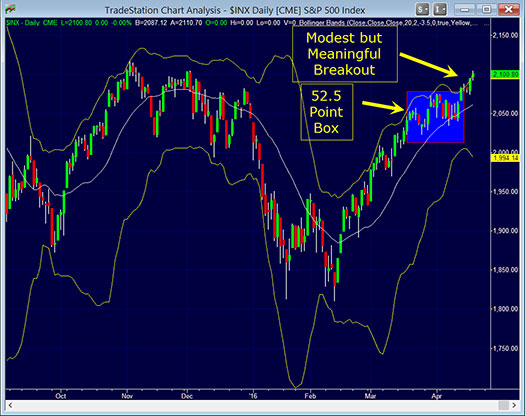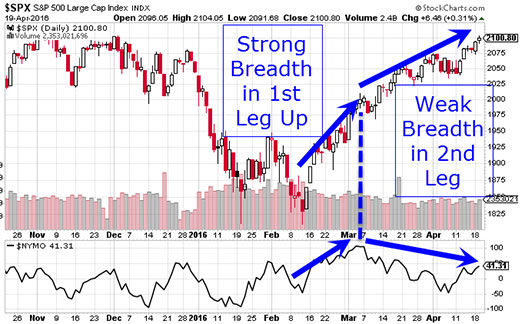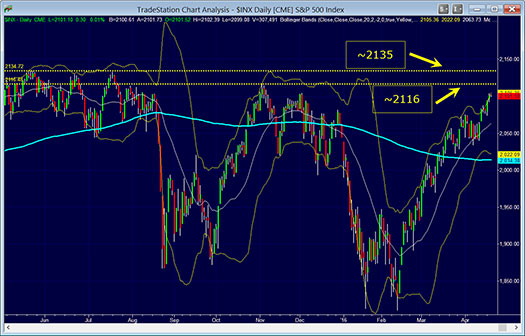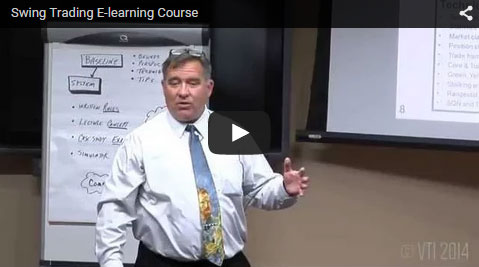Tharp's Thoughts Weekly Newsletter
-
Article: Goals Stated as a Well-Formed Outcome by Van K. Tharp, Ph.D.
-
Workshops: New workshops are coming in July. Two have never been offered before!
-
Tip: U.S. Markets — The Breadth Problem & Reporting Your Projections by D. R. Barton, Jr.
-
NEW Workshops This July!
In addition to Van Tharp's newly revised Infinite Wealth workshop, we also have two brand new workshops from Ken Long, all three coming in July!
Ken gives a nice, short, overview of the Systems Thinking Workshop For Traders in this 9 minute video:

Feature Article
Goals Stated as a Well-Formed Outcome:
The Super Trader Program Example
by Van K. Tharp, Ph.D.
Click here to resolve formatting problems
When you have goals, you typically produce some sort of result through acting on them. If you want these goals to produce effective end ecological 1 results, however, then the goals must fit the criteria of being well-formed.
These are a set of five conditions for goal outcomes, established through the NLP community. They include:
- The outcome must be stated in positive terms. Generally, it is practically and logically impossible to set a goal which is expressed in terms of the negative of an experience. So if someone said, “I don’t want to argue with my wife,” then a better approach is find out what the person wants instead of the negative experience. For example, it might be stated instead as: "I want to feel positive about whatever my wife does knowing she had a good heart and great intentions." That’s much easier to achieve that the negative experience of not arguing.
- The outcome must be testable and demonstrable — in other words, stated in terms of sensory specific evidence. Thus, you need to know through evidence you can perceive that you are moving toward your results so your goal must state how that will be accomplished. Ideally, two criteria are necessary: 1) to be clear about how you will know you have achieved the outcome for yourself, and 2) how will others in your life know that you have achieved the outcome.
- The desired state must be initiated and maintained by the student, not the coach. The locus of control must be with the student which is usually in the form of accessing resources. So, if someone said, “I want my wife to stop criticizing me and telling me to get a real job,” that outcome would be out of the person’s control. Instead, the person would need to state a positive outcome such as determining what the wife might being doing instead of criticizing you and saying to get a real job. The answer also needs to be demonstrable, as described above. Then you need to determine what resources are necessary to achieve that outcome, with those resources being in the client’s control.
- The goal must preserve any positive by-products of the present state. Those positive by-products tend to be negative habits (i.e., drinking too much) that are used to achieve the positive state (i.e., feeling relaxed). So whatever is being done must also preserve the relaxation that is desired or the person might just go back or develop other bad habits to achieve them. For example, many people who are obese may have an issue with the opposite sex and feel unattractive. What would happen if they felt they were attractive and were then approached by people of the opposite sex? If their goal was to “become attractive”, then they would need the resources to be able to deal with that particular issue. In addition, the goal must be able to deal with any future impacts of the desired outcome. So what will the person's system gain or lose as a result of achieving the desired outcome. For example, if you become a successful trader, what are the ramifications of achieving that? What if you have issues with having a lot of money — for example, what if you believe that people will take advantage of you; cheat you; or if you believe that rich people abuse their families. The new outcome must be able to deal with those possibilities.
- Finally, the desired outcome must be appropriately contextualized and be ecologically sound – i.e. taking into account your other responsibilities, the people around you, etc. For example, if you state your outcome using a universal quantifier such as (all, always, never), you may find situations in which the outcome desired is not appropriate. I always want to follow my trading rules, however, you might find conditions in which your trading rules might stop working, such as when the market type changes. So you must be able to contextualize the outcome. A good way of understanding that is that most beliefs, no matter how bad they might seem, might have some context is which they are useful. Similarly, most beliefs have contexts in which they are not useful.
Establishing a Well-Formed Outcome for the Super Trader Program
So now let’s look at the Super Trader program as a goal (i.e., to become a Super Trader) with a well-formed outcome. So here is my version of it.
The Super Trader program will produce massive transformation to enable candidates to be able to follow the Tharp Think principles, develop a great business handbook to run a trading business, and develop three non-correlated trading systems (that work in different market types) that they trade profitably and at 95% or higher efficiency.
This statement still needs a little more detail to flesh out the well-formed conditions. It is definitely stated as a positive outcome.
So how is the outcome testable and demonstrable? How do we know the outcome is achieved and that progress is being made?
Outcome One: Five Major Transformations
I talked about these transformations in a recent article about the Super Trader program.
- First, I expect a candidate’s awareness and level of consciousness (pretty much synonymous) to increase during the program. We measure this by the happiness test. By the end of Super Trader 1, I would like their happiness score to be consistently above 60 (although 70 is better). This is measurable.
- Second, I would like them to consider that their beliefs are useful (within a context) and not absolute. I would also like them to understand how they can easily change their beliefs. This would be demonstrated by numerous examples.
- Third, negative states should be observed and witnessed and then accepted. Acceptance is a metastate which tends to change the basic state to a much higher level, however, I want them also to have some mastery over feeling release. When I see evidence of this sufficiently in their weekly reports, then I know it is accomplished.
- Next, I’m looking for their ability to converse with their Higher Self and to do Transformational Meditation on issues that come up. Examples of this would include daily dialogues with their Higher Self and successful completion of Libby Adams 28 day course.
- Finally, I’d like them to find their purpose in life and to be certain that they have actually found their purpose.
- And naturally, all these transformations will lead to numerous personal transformations.
These are demonstrated on an ongoing basis through the successful completion of the Super Trader lessons and their weekly progress reports. There are currently 20 lessons in the new Super Trader 1.
Outcome Two: Develop a Trading Business Rooted in A Strong Business Handbook that proves they have a strong psychological foundation and find the resources to solve any problems that arise
- This is demonstrated by the satisfactory completion of their business handbook that meets all the criteria given to them for the handbook. Most of those criteria are given in Trading Beyond the Matrix.
- In addition, they will demonstrate this goal on an ongoing basis through the completion of the lessons in Super Trader 2.
Outcome Three: Develop Three Non-Correlated Systems that Work in Various Market Types
- This outcome is easily demonstrated through their presentation of each of their systems, to include the beliefs behind the system; the logic behind the system; why it will work in certain market types and not work in other types; and whatever statistics they can present on the performance of the system.
Outcome Four: Trade the Systems Profitably at 95% Efficiency or Better.
- Demonstration of this is obvious through monthly trading logs showing their profits and losses and mistakes made. And when they have 100 trades, meeting the criteria, with at least 10 from each system, then they are eligible for graduation.
Outcome Five: Demonstrate that they have developed the skill to handle any new psychological roadblocks that might come up during ST 2 and ST 3.
- This is demonstrated through weekly reports about roadblocks that come up and how they handle it.
- Its culmination is graduation.
So How is the Program Maintained by the Student?
This one is fairly easy because Super Trader candidates do the work and send in the lessons and weekly reports. If they don’t do it, it doesn’t get done. My job as their coach is to answer questions, help them get through difficult times when they ask for help (primarily on their psychological issues), and to make sure they do a good job on the lessons. Doing a good job on the lessons is critical for their progress.
It’s all about having the appropriate resources to accomplish each task. Generally, a good coach helps clients by asking questions. I noticed recently in watching videos of Dr. L. Michael Hall’s metacoaching program that about 90% of what a good coach does is ask questions. And the questions are all about helping the client find their own resources.
How Does the Program Deal with the Positive By-Products of Where they are now and with the Future Implications of What will happen when their achieve their goals?
One difference between the Super Trader program and the normal NLP client coach relationship is that our goals are huge and involve finding and tackling many issues. For example, one lesson requires that they identify and evaluate the impact of about 400 identity level beliefs. This finds and overcomes many issues before they ever could arise in the program. Another lesson requires that they come up with a complete life history, including beliefs formed and issues that might have come up in the past. Again, this helps them identify demons well before they arise in the Super Trader Program. And finally we have at least four lessons that deal with negative states or resources that they must process. As a result, when they complete all of this work we expect that very few issues will come up during trading that they have not already dealt with.
In addition, when they complete ST1, they must also respond to a number of questions to show that they are capable of facing whatever issues might come up when they start applying what they have learned to the program. This turns the application sections, developing a trading business, developing three systems, and trading efficiently into an applied psychological exercise.
How is the Program Appropriately Contextualized and Ecologically Sound?
First, trading is contextualized in the program as the candidates’ full time job (if it isn’t already) or at least a major supplement to their income. Thus, the whole program lies within the context of a major aspect of their lives, not some minor problem area.
Second, they will complete an extensive program of evaluating their beliefs using a certain context and not in others. And they will have learned that there are probably no absolute beliefs that apply to all situations. Context is rooted in their educational process.
Third, one of the major transformations is to find their life’s purpose and to have trading fit within that context. Finding one’s purpose generally changes most people’s lives and when trading becomes part of that context, it almost guarantees a sound ecology check.
Finally, everyone in the program learns that trading is simply a measure of their spiritual growth. Here spirituality is defined as a larger system — family, community, global, universal. It’s an inner journey of discovering who they are. Once again, this context becomes a huge ecological check.
Summary
If this information about using well-formed goals is new to you, I encourage you to begin to implement this practice for current goals in your life. I recently restructured the Super Trader Program (see last week’s article), and I have personally found the well-formed goal questions very impactful in this process!
1. The ecology check is a key step in every NLP technique. It essentially involves assessing the impact that a particular change of behavior will have on the rest of the system or systems of which the person is a part.
About the Author: Trading coach and author Van K. Tharp, Ph.D. is widely recognized for his best-selling books and outstanding Peak Performance Home Study Program—a highly regarded classic that is suitable for all levels of traders and investors. You can learn more about Van Tharp at www.vantharp.com. His new book, Trading Beyond The Matrix, is available now at matrix.vantharp.com.
Workshops
Here's Just A Bit About Each New Workshops Coming In July
INFINITE WEALTH — July 8-10
The key to being infinitely rich— not having to work ever again— is to have assets and passive income (income you get without working) that are equal to or greater than your expenses.
Objectives
- To define what a game is so that you can see that most games cause you to lose.
- To illustrate the elements of the money game so you can begin to awaken to how winners play the game.
- To help you understand the domain at which you play the money game.
- To awaken you to a new way to play the wealth game.
- To give you choice with respect to how you play the wealth game in the future.
SYSTEMS THINKING FOR TRADERS — July 12-14
Systems Thinking Processes You Will Learn
1. Plan-Prepare-Execute-Assess Process
2. Organizing your workspace (time of day and application of strategy and management)
3. House of trading
4. Holistic view of time-frames and overlaps
5. System-Self-Market integration model
6. Staff call and management of parts
7. Input-process-output + environment: SIPOC systems thinking
8. OODA loop for decision-transaction processing
9. 10 minute mental toughness + zero state exercise
10. Systematic process improvement through use of 30-60-90 trade MA
11. Four part learning journal
12. Virtuous circle for continuous improvement
13. Clearing and sense making meditation
ADVANCED ADAPTIVE SWING TRADING — July 15-17
In this new three-day workshop, Dr. Ken Long will present a series of advanced, adaptive trading systems that work well in the swing period holding time-frame – from two days to two weeks.
Adaptive Trading Systems – A Quick Q & A
What is an Adaptive Trading System?
An adaptive trading systems have rules and rule parameters that adjust to market conditions and price conditions rather than remaining constant.
Which kind of rule parameters work better, adaptive or mechanical?
They both work well, they just work differently. Mechanical rules are more easily understood, are easier to program, and they are easier to execute. Mechanical rule-based systems typically do not adjust to changing market conditions and therefore are out of the market at times when the condition criteria are unmet. These are the kind of systems detailed in the Swing Trading Elearning Course.
Adaptive rules require a better understanding by the trader of price action, of self and of the market. These systems can also take more time to monitor and to execute.
If I have not been trading very long or I have not been trading more mechanical systems, can I still attend?
With a warning— this is an advanced technical workshop intended for traders with an intermediate or advanced level of experience. Ken will move along at a fast pace in this workshop focusing on more advanced topics rather than on introductory topics. Newer traders will feel at a disadvantage in the workshop. Taking the Swing Elearning course would be a much better route for newer traders.
Am I required to take any other course or workshop before this one?
No other course is required as a prerequisite. We do recommend that you have either attended a previous swing trading workshop, day trading workshop, or that you have completed the swing trading elearning course. The more trading experience or knowledge that you have, the more you will benefit from this advanced workshop and the more likely you will be able to trade these advanced systems effectively after you get back home. We are offering an attractive discount on the Swing Elearning course for the attendees of this workshop. But understand, this advanced workshop is not an extension of the systems in the elearning course, but rather altogether different systems with different objectives.
What is the discount on the Swing Elearning course to attendees of this live workshop?
When you register for this workshop you will have the option of purchasing the Swing Trading Systems E-Course for more than 20% off. The E-course is $2,540 but when you register for this workshop you'll have the option to purchase for $1,995. This is the lowest price we have offered on this home study course.
Remember, taking the e-course first is to give you more trading knowledge experience. The Adaptive Swing Systems taught in the workshop ARE NOT SIMILAR to the systems in the E-course. The E-Course is NOT required for the workshop, but trading experience is.
Click Here To Learn More
Combo Discounts available for all back-to-back workshops!
See our workshop page for details.
Trading Tip

U.S. Markets — The Breadth Problem & Reporting Your Projections
by D. R. Barton, Jr.
Click here to resolve formatting problems
In last week’s Tharp’s Thoughts Trading Tip, I asked the faithful and well-informed readers of these articles to send in your expectation for the market’s next move. In the article, I reported that the market had been stuck in a trading range or “box” for almost four weeks and wondered what people were thinking. At the end of the article, I posed the following question:
Which will the S&P 500 Cash index reach first:
- 2,282.5 (up 10%) or
- 1,867.5 (down 10%)?
Survey Says . . .
The responses were overwhelmingly in favor of the second option: down 10%. In fact, the bears outnumbered the bulls almost 10 to 1! Now this wasn’t a scientific survey by any means, but that’s a surprisingly one-sided outcome. A big thanks to all of you who took time to email me. Of course it may be quite a while until the market answers the question so if you haven’t had a chance to weigh in, please send me an e-mail (the address is at the end of this article).
Market Check
Here’s a price chart updated with the action since last week which shows the range box mentioned:

As the market has stretched to its current level within 35 points of the S&P's all-time high, there is one development that’s on my radar screen — there has been a lack of broad participation (or market breadth) in the last month of trading. Let’s look at a chart that shows the S&P 500 cash index in the top graph and a measure of market participation (or breadth) called the indexed McClellan Oscillator in the bottom part of the chart:

The McClellan Oscillator measures the momentum of breadth by comparing the 39 day exponential moving average (EMA) of the advance/decline line to the 19 day EMA of the advance/decline line. The Stockcharts version is indexed so that indicator value remains between -100 and +100 (for more on this you can read the excellent explainer at Stockcharts.com, clicking on the ChartSchool tab, selecting market indicators and finding the McClellan Oscillator).
What does this mean for us? With fewer stocks participating in the second part of this strong up move, we can infer that the advance is weaker from both a technical and market sentiment perspective than the earlier part of the move up off of the February lows. So it would be logical to expect at least some modest profit taking and a market pullback in the near-term. Balancing that expectation is the tendency for these grinding moves up to go further and longer than we expect.
Where Now?
We have two clear resistance levels overhead now in the S&P 500 – let’s take a look:

Notice that the November 2015 swing high is about one daily range above our current price and that the all-time high from last May is just under two daily ranges away. This market has given us a rebound (off the February lows) that is bigger than most people realize. The price action at the upcoming two resistance levels are important to watch.
You can still send your market direction vote (and your thoughts and comments) to drbarton “at” vantharp.com – I always enjoy hearing from you.
Great Trading,
D. R.
About the Author: A passion for the systematic approach to the markets and a lifelong love of teaching and learning have propelled D.R. Barton, Jr. to the top of the investment and trading arena. He is a regularly featured analyst on Fox Business’ Varney & Co. TV show (catch him most Thursdays between 12:30 and 12:45), on Bloomberg Radio Taking Stock and MarketWatch’s Money Life Show. He is also a frequent guest analyst on CNBC’s Closing Bell, WTOP News Radio in Washington, D.C., and has been a guest on China Central Television — America and Canada’s Business News Network. His articles have appeared on SmartMoney.com MarketWatch.com and Financial Advisor magazine. You may contact D.R. at "drbarton" at "vantharp.com".
Free Book
FREE Book!
TRADING BEYOND THE MATRIX
The Red Pill for Traders and Investors
We pay for the book, you pay for shipping.
ALL YOU HAVE TO DO IS CLICK HERE!
Eleven traders tell their stories about transforming their trading results and lives, in this 400 plus page book.
Below is a brief video on how powerful this book is to traders.

Swing Trading Systems E-Learning Course

Ken Long's systematic approach to swing trading with 5 distinct trading systems. This course has over 10 hours of instruction with significant follow-along documents included for students to download.
Review the videos as many times, and as often as you like, for one full year. Plus, you receive a bonus workshop at no extra charge—Dr. Van Tharp's Tharp Think Essentials!
If you are interested in both this video home study program (featuring mechanical, rule-based systems) and our new Advanced Adaptive Swing workshop (adaptive trading systems have rules and rule parameters that adjust to market conditions and price conditions rather than remaining constant) you benefit by buying both at the same time.
When you register for the workshop you can get a 22% discount on this home study.
The home study is not required to attend the workshop, however, an understanding of the systems in the the video home study may help a less experienced trader better understand the more advanced trading style which will be presented in the workshop. The systems, however, are totally different and the Advanced Adaptive Systems Workshop does not build upon the systems in the home study.
You can complete this course at your own pace, from the comfort of your own home or office, and access the materials as many times as you wish during your 1-year subscription period.
Take a look at this video from Ken to learn more about this course.

We have extensive information about the Swing Trading System e-learning course, including how to purchase...click the link below!
Learn More About The Swing E-Learning Course...
Matrix Contest
 Enter the Matrix Contest Enter the Matrix Contest
for a chance to win a free workshop!
We want to hear about the one most profound insight that you got from reading Van's new book, Trading Beyond the Matrix, and how it has impacted your life. If you would like to enter, send an email to [email protected].
If you haven't purchased Trading Beyond the Matrix yet, click here.
For more information about the contest, click here.
Ask Van...
Everything we do here at the Van Tharp Institute is focused on helping you improve as a trader and investor. Consequently, we love to get your feedback, both positive and negative!
Send comments or ask Van a question by clicking here.
Also, Click here to take our quick, 6-question survey.
Back to Top
Contact Us
Email us at [email protected]
The Van Tharp Institute does not support spamming in any way, shape or form. This is a subscription based newsletter.
To change your e-mail Address, e-mail us at [email protected].
To stop your subscription, click on the "unsubscribe" link at the bottom left—hand corner of this email.
How are we doing? Give us your feedback! Click here to take our quick survey.
Call us at: 800-385-4486 * 919-466-0043 * Fax 919-466-0408
SQN® and the System Quality Number® are registered trademarks of the Van Tharp Institute and the International Institute of Trading Mastery, Inc.
Be sure to check us out on Facebook and Twitter!
 
Back to Top |